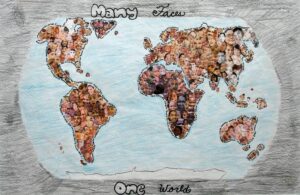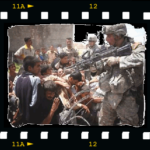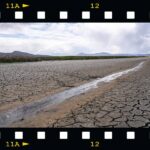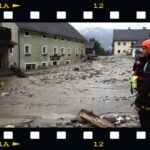The world today
Since the Lay Salvatorians began to develop in the 70s and 80s of the last century, their image has changed a lot. While the first Lay Salvatorians were dropouts from the two Salvatorian religious communities, real lay people have increasingly built up the present communities. And with that, a somewhat different spirit or outlook came to light. Equal in spiritual content but differently expressed by life.
In the following I want to draw an image of Lay Salvatorians today now and how the development could go forward into the future.
 The world we live in has a lot of different faces and with it a lot of different life issues and challenges. Living our Christian Catholic faith is not easy in many places and is becoming increasingly difficult even in those areas where it was previously considered traditional. The reasons for this are diverse and very much go hand in hand with changes in our values and points of view of society.
The world we live in has a lot of different faces and with it a lot of different life issues and challenges. Living our Christian Catholic faith is not easy in many places and is becoming increasingly difficult even in those areas where it was previously considered traditional. The reasons for this are diverse and very much go hand in hand with changes in our values and points of view of society.
 Our current time is a time full of insecurity and external threats that affect and concern each of us in different ways. We had to make some painful experiences with the CoVid pandemic, be it through the prescribed distancing, the breaking off of accustomed ways of life and behavior, or even the loss of family members or friends.
Our current time is a time full of insecurity and external threats that affect and concern each of us in different ways. We had to make some painful experiences with the CoVid pandemic, be it through the prescribed distancing, the breaking off of accustomed ways of life and behavior, or even the loss of family members or friends.
 The crisis and armed violence in Ukraine and the related economic consequences reach far beyond the actual site of the conflict and affect many innocent people around the world with hunger, food shortages, suddenly inflated and barely affordable energy prices, job losses, and more. This development can set new conflicts and armed confrontations in motion.
The crisis and armed violence in Ukraine and the related economic consequences reach far beyond the actual site of the conflict and affect many innocent people around the world with hunger, food shortages, suddenly inflated and barely affordable energy prices, job losses, and more. This development can set new conflicts and armed confrontations in motion.
But we should also remember that in so-called peaceful times we have approximately 40 armed conflicts with death and injured people daily, and don’t forget about the displaced persons.
 The climate crisis is another big task and challenge which shows us our misbehavior towards the environment and the treasures of this world given to us by God. The excessive exploitation of the landscape and its resources, destruction of forests, drainage and detour of water, misdirected agriculture and livestock, inadequate disposal of our garbage, industrial emissions and residues, the exhaust fumes of our transport routes by land, air or sea, and so on lead to shifts in the vulnerable balance of the atmosphere, oceans and soils. The consequences are on the one hand lack of rain, drought, water shortage,
The climate crisis is another big task and challenge which shows us our misbehavior towards the environment and the treasures of this world given to us by God. The excessive exploitation of the landscape and its resources, destruction of forests, drainage and detour of water, misdirected agriculture and livestock, inadequate disposal of our garbage, industrial emissions and residues, the exhaust fumes of our transport routes by land, air or sea, and so on lead to shifts in the vulnerable balance of the atmosphere, oceans and soils. The consequences are on the one hand lack of rain, drought, water shortage, large-scale forest fires, and loss of vegetation in addition, but on the other hand unprecedented flooding and destruction by intense rain, mud-flows, hail, as well as storms. There are only very few small-scale regions in the world that have been spared so far.
large-scale forest fires, and loss of vegetation in addition, but on the other hand unprecedented flooding and destruction by intense rain, mud-flows, hail, as well as storms. There are only very few small-scale regions in the world that have been spared so far.
All of this affects us Lay Salvatorians as well and poses questions and challenges that require us to anchor our personal faith and trust in God more deeply and fully. Faith will face difficulties if it has not developed and matured, if it has not learned what is based in nature or in God’s providence, or is brought about only by human action.
As Lay Salvatorians, we are on the front line of proclamation and must face some unexpected challenges. This should be done by all ways and means that God’s love inspires. In doing so, we have to recognize the signs of the time and respond to their questions. The words of Blessed Francis Jordan: “As long as there is one person on earth who does not know God and does not love God above all things, you dare not allow yourself a moment’s rest.“, must be seen in a much broader context today.
Faith and/or religious life cannot be lived apart from or in contradiction to the real world but must be a part of it, permeating it like the hyphae1 of fungi. I am already aware that this point of view can provoke rejection in some or be seen as negatively tainted. Nevertheless, this comparison should be seen positively, because without different fungi, for example, most trees are not properly viable or develop only badly, to think in my profession as a landscape gardener and planner.
Which brings us closer to the question:
What is the value of true faith?
 In a text on a similar topic, I compared it to a situation a few years ago when we were discussing the value of “green furniture” in our environment. What is the value of a tree in the landscape, or a fish in a river – comprehensive and not just as a dead commodity? This may sound unusual at first, but when these effects and connections gradually become aware, a very differentiated and complex picture emerges. What previously seemed outdated, worthless, commonplace or uninteresting suddenly takes on a new, previously unnoticed valence and can develop into a MUST HAVE.
In a text on a similar topic, I compared it to a situation a few years ago when we were discussing the value of “green furniture” in our environment. What is the value of a tree in the landscape, or a fish in a river – comprehensive and not just as a dead commodity? This may sound unusual at first, but when these effects and connections gradually become aware, a very differentiated and complex picture emerges. What previously seemed outdated, worthless, commonplace or uninteresting suddenly takes on a new, previously unnoticed valence and can develop into a MUST HAVE.
A good example of this are my children. In my apartment, I have many different plants that I cherish and care for, some of which I also make grow from seed. A few years ago, I was completely out of line, in their eyes, – just like a freak. In the meantime, they all have an apartment themselves. And what do you think grows and thrives in it – partly with much devotion is cared for? And the results are proudly presented to friends? – Various interesting plants.
In my opinion, this example is comparable to faith. Faith is and can be a great help and carrier for people, physically, psychologically, and spiritually. It is not for nothing that faith is said to be able to move mountains. An intensive relationship with God and a life rich in prayer can have a great positive impact on a person’s mental hygiene and can contribute to greater resilience in daily life. A possible aspect and/or argument against those who are against religion or do not see a sense in it anymore. If faith and religion are thus lived and practiced in the sense of charity, keyword: “Sermon on the Mount”, certainly represents not only value for the person but also an additional benefit for society. This would promote peaceful coexistence and mutual respect and mindfulness – also toward the environment and its goods.
1 → A hypha (from Ancient Greek ὑφή (huphḗ) ‘web’; pl. hyphae) is a long, branching, filamentous structure of a fungus, oomycete, or actinobacterium. In most fungi, hyphae are the main mode of vegetative growth and are collectively called mycelium.
This text is the first part from the lecture "Lay Salvatorians in the modern world" by Christian Patzl on the occasion of the retreat "Lay Salvatorians in the modern world" of the Australian Salvatorian Family on Oct., 1st 2022Christian
Latest posts by Christian (Posts)
- Holy Saturday – Sábado Santo - 29/03/2024
- Good Friday – Viernes Santo - 28/03/2024
- Maundy Thursday – Jueves Santo - 27/03/2024
image sources
- WorldFaces_(800_x_600): © https://www.laysalvatorians.org/spiritual
- CoVid19: © https://www.laysalvatorians.org/spiritual
- Konflikt: © https://www.laysalvatorians.org/spiritual
- tree_worth_(800_x_600): © https://www.laysalvatorians.org/spiritual



